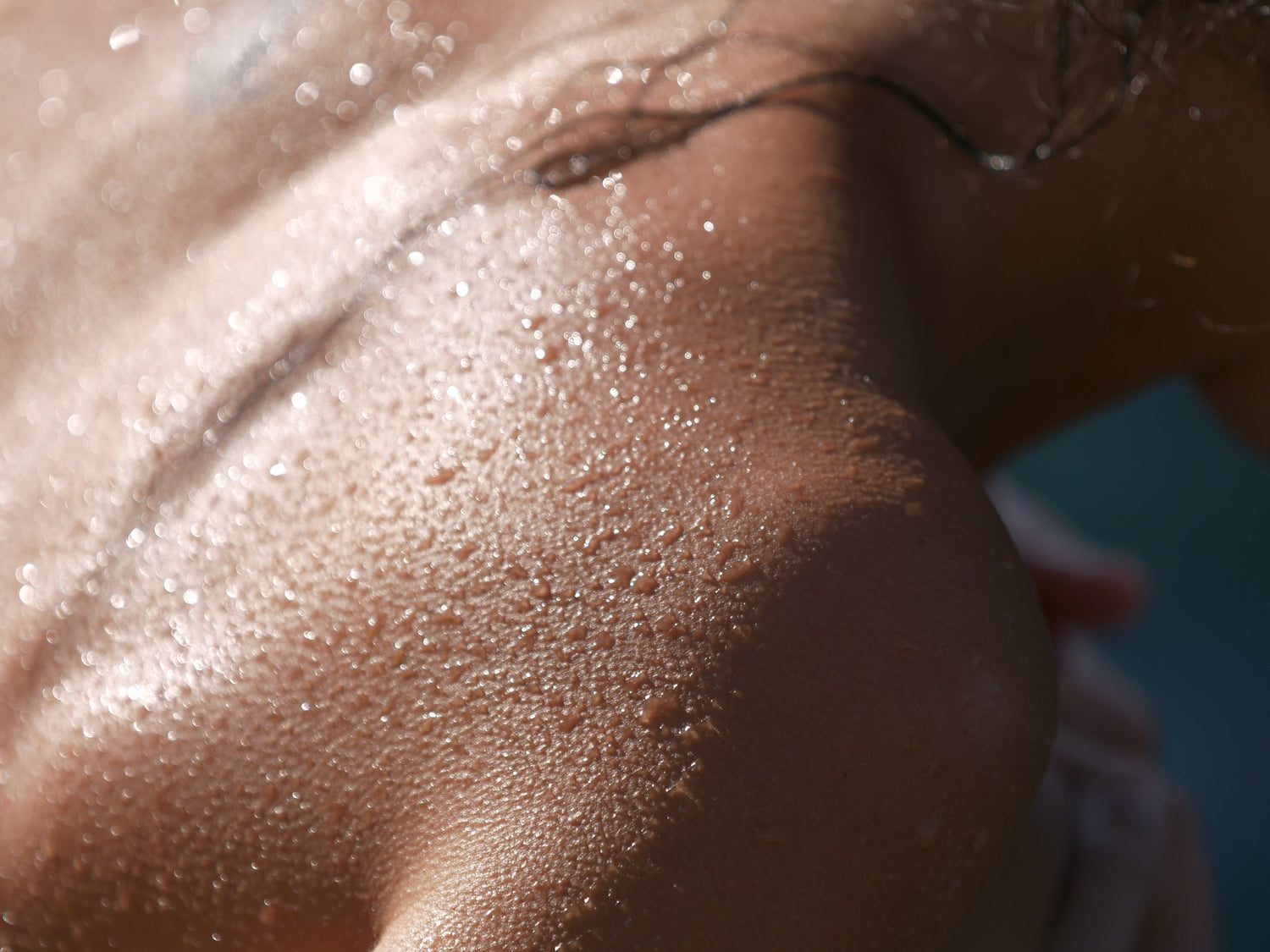The secret to healthier, more radiant skin starts with your body's built-in shield: the skin barrier. Officially called the stratum corneum, this living layer works tirelessly to defend against external factors and biological stressors.
The skin barrier protects us from our environment, everything from harsh UV rays and pollution to exposure to bacteria and microbes. But many of these same elements can challenge its delicate balance. And unfortunately, a damaged skin barrier can't hold moisture or lock out pathogens and toxins.
Learning how to repair the skin barrier is essential for long-term skin health. By giving your skin the proper care (gentle cleansing, consistent hydration, and targeted support), you can restore resilience and lock in moisture for an age-defying, smooth, and glowing complexion.
What Is the Skin Barrier?

The skin barrier, a vital component of the epidermis, is known as the stratum corneum. This is the outermost layer of the epidermis and is essential for protection, hydration, and immune defense.
Even when skin feels soft, smooth, and supple, at the molecular level, the stratum corneum is actually more like a thick brick wall. This protective wall is made up of corneocytes (flattened, dead skin cells), which act like the protective "bricks," while lipids (oils) serve as the "mortar" that binds those cells together.
These tightly packed layers form a physical and biochemical shield, serving as the body's first line of defense against environmental chemicals, toxins, and pathogens that can enter the body through the skin. It's also our natural shield against the damage of harsh UV rays.
But the skin barrier isn't just a protective layer against external elements. It actually helps keep moisture in by restricting evaporation (trans-epidermal water loss). A healthy stratum corneum translates into healthy, hydrated skin.
And this humble barrier doesn't stop there. The skin barrier plays a crucial role in maintaining the skin's greater microbiome. It's a thriving community of beneficial microorganisms that live on the surface and work in harmony with the stratum corneum to act as yet another layer of defense against the pathogens, irritants, and environmental stressors we face every single day.
It is truly astonishing just how much work the skin barrier does to keep us safe from all the elements that swirl around us at any given moment.
All the Building Blocks that Make Up the Skin Barrier
Clearly, the skin barrier is a complex yet beautifully orchestrated ecosystem, with countless parts working together to create the body's first line of defense. Each of these components plays a vital role in keeping your skin balanced, protected, and resilient.
While it may seem intricate, we can make this complexity more tangible by breaking it down into bite-sized pieces:
Corneocytes
Corneocytes are flattened, dead skin cells. While it may sound unappealing, these old skin cells serve a critical purpose. Remember, these are the protective "bricks" in your skin's exterior wall. They provide a sturdy structure that keeps the barrier strong in the face of whatever Mother Nature throws at it.
Lipids
Lipids, also known as oils, are a blend of ceramides, cholesterol, and fatty acids that act as a natural waterproofing. By filling the spaces between skin cells, like the mortar between bricks, lipids lock in hydration while keeping out environmental stressors.
Natural Moisturizing Factors (NMFs)
Natural moisturizing factors (aka NMFs) are water-loving compounds (urea and amino acids are two examples) that help the skin attract and hold moisture. These are the hydrators that keep the barrier flexible and supple, and protect against dry skin.
Microbiome
The microbiome is the invisible layer of living organisms on the skin's surface. It's a thriving and impossibly diverse community of beneficial bacteria that call your skin home. They help crowd out potential harmful microbes, soothe inflammation, and support overall skin health.
What Does a Damaged Skin Barrier Look Like?

Your skin barrier is strong in the face of environmental stressors, but its balance is a delicate one. Day-to-day life can chip away at its integrity, leaving the skin vulnerable to dryness, redness, and inflammation.
Sometimes it's the little things that break down its protective qualities. It could be a cleansing product that is too harsh. Or you may be exfoliating a bit too often. Both products can unnecessarily remove the natural lipids that help lock in moisture. Sun exposure, urban pollution, and shifts in temperature or humidity can also subtly deplete your skin's protective oils over time.
Even the most well-intentioned routines can use fine-tuning. Potent products, such as retinoids and acids, work best when used minimally and paired with powerful moisturizers.
Life itself plays a role, as well. Periods of stress, insomnia, or simply not drinking enough water may slow your skin's natural rejuvenation. And yes, diet also plays a role. There is a direct correlation between an unhealthy diet and an unhealthy skin barrier.
Of course, looking at this laundry list of damaging influences can make the world feel impossible to navigate in a way that keeps your skin healthy. But there's no need to fear the world around you. By understanding these everyday influences, you can make small, supportive shifts that keep your skin barrier strong and healthy.
What are the Signs of a Disrupted or Weak Skin Barrier?
The telltale symptoms of unhappy skin are all too familiar for many of us. These are the blemishes, redness, dry patches, and other uncomfortable indications that we strive so hard to avoid.
Here are the most common signs of a damaged skin barrier:
-
Redness
-
Inflammation
-
Dryness and flakiness
-
Too-tight-feeling skin
-
Breakouts, especially non-hormonal acne
-
Roughness and excessive texture
-
Dullness
-
Heightened sensitivity to new products
If you have one or more of these minor symptoms, how long does the skin barrier take to heal?
Although it's always hard to make sweeping predictions about very personal conditions, issues should start to clear up within a few days with a few small changes. If symptoms persist for more than a few weeks, you should seek professional advice.
How To Strengthen and Support the Skin Barrier

Every day, your skin works tirelessly to protect you from environmental stressors and toxins. But the good news is that it's literally built for the job. And while your skin is doing the heavy lifting, there are plenty of simple ways you can help support skin barrier repair and keep it performing at its best.
This list may look long at first glance, but many of these steps are likely already part of your routine. And if they're not, they're easy to find and even easier to add.
Moisturize, Moisturize, Moisturize!
Hydration is the heartbeat of a healthy skin barrier. A gentle, daily moisturizer helps lock in water and replenish lost lipids to help rebuild your skin's natural "brick and mortar" structure. Look for products rich in one or more supportive ingredients, like ceramides, fatty acids, and occlusives.
Never Skip SPF
There is a reason why skin care experts universally agree on the importance of sunscreen. According to the research, most skin cancers (up to 80–90%) are linked to cumulative lifetime UV exposure, reinforcing the importance of daily protection. Plus, up to 80% of visible skin aging is directly linked to lifetime sun exposure. Never leave the house without applying sunscreen, even on cloudy days.
Regularly (and Gently) Cleanse
Swap out harsh cleansers containing long lists of active ingredients for gentler alternatives. Simple, soothing cleansers that are properly pH-balanced and fragrance-free will ensure you aren't stripping away too much of the healthy microbiome or too many of the essential components that provide the protection.
Avoid Harsh Exfoliators
It's easy to fall into the trap of over-exfoliating. Yes, there are benefits to physically or chemically scrubbing the surface of your skin, but remember, this is the essential protective barrier between you and the world.
Using harsh exfoliators or exfoliating too frequently will strip away the skin barrier's integrity, potentially causing far more damage than these products claim to correct. Instead, focus on repair and balance first.
Work with Supportive Ingredients
Not all ingredients were created equal when it comes to supporting a compromised skin barrier. Pull out all the products in your daily routine, read the labels, and update with a few new ones that can help rejuvenate and repair your stratum corneum.
The best skin barrier repair products are gentle ones. Hemp-based topicals like Skin Therapy Body Butter, a cream rich with CBD and other antioxidants, are powerful tools for soothing and nourishing your skin and helping you achieve that natural glow. Other skincare ingredients to keep on hand include niacinamide, which enhances natural lipid production, and hyaluronic acid, a hydration powerhouse.
How Prima Supports the Skin Barrier

How can you restore your skin barrier? Start with Prima.
Every Prima formula is crafted with plant-based, clinically studied ingredients to help your skin stay resilient. And because true care never compromises, every one of our products is free from harsh disruptors that can break down the skin's natural barrier.
-
Take our Night Magic CBD Facial Oil. This is a potent blend of botanically derived essential fatty acids, antioxidants, and hemp extract to replenish lipids and reduce visible signs of stress.
-
Then, our Skin Therapy Ultra-Rich Body Butter cocoons the skin with shea butter, hemp extract, and nourishing plant oils to lock in moisture and soothe irritation.
-
For lightweight, all-over hydration, Beyond Body Oil combines omega-rich oils, hemp extract rich with CBD, and adaptogenic botanicals to restore balance without heaviness.
Used separately or together as part of a deeply nourishing weekly skincare regime, Primas products are crafted with the same high-quality, skin-loving oils that lock in moisture, soothe irritations, and help repair skin barrier damage.
When Should You Seek Professional Help?
Many of the most common symptoms of skin barrier issues are mild. Red patches, irritations, and blemishes often respond well to changes in your skincare routine and the introduction of gentle skincare products.
But if symptoms linger beyond two to three weeks or flare up into something more serious, it may be time to check in with a dermatologist or healthcare provider. Persistent redness, eczema-like patches, peeling, or discomfort that doesn't improve could signal a deeper medical issue.
A professional can offer more support, dive deeper into the causes, and recommend the best course of treatment.
Protect the Barrier to Support Your Skin

If you take nothing else from this deep dive into the skin barrier, remember this: The stratum corneum is a delicate ecosystem, and when it's nurtured, everything thrives. Supporting its resilience doesn't usually mean overhauling your entire routine. Often, it's about small, intentional shifts and choosing more supportive ingredients.
Because even a broken skin barrier can be restored with consistent, gentle care. If your skin is showing signs of damage or irritation, focus on building a routine around balanced, soothing formulas with protective qualities.
At Prima, our mission is to help you find that balance with products crafted for the whole you: body, mind, and, of course, skin barrier function. Explore our whole line of skincare, formulated with clean, botanically derived, and scientifically studied ingredients.
Disclaimer
The information provided in this content is for general knowledge and educational purposes only and should not be considered medical advice. Our products are not intended to diagnose, treat, cure, or prevent any disease or medical condition. Individual results may vary. Always consult with a qualified healthcare professional before using CBD or any hemp-derived products, especially if you have underlying health conditions, are pregnant or nursing, or are taking prescription medications.





